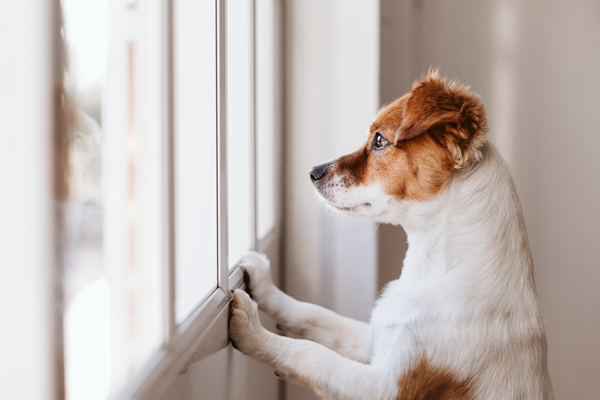
It happens every year, like clockwork. The backpacks come out, the alarm clocks ring earlier, and suddenly the house that’s been buzzing with summer activity turns eerily quiet. For parents, it’s the familiar back-to-school scramble. For dogs it can feel like abandonment.
Welcome to the world of separation anxiety in dogs – a problem that spikes during seasonal transitions like, yes, the return to school.
What Is Separation Anxiety in Dogs?
Separation anxiety – also known as separation-related distress – isn’t just about missing you. It’s a full-bodied panic response to being left alone or without a specific attachment figure. Some dogs become anxious, others get frustrated, some are just plain bored. It’s not a one-size-fits-all emotional state, and that’s part of what makes it tricky.
Early Red Flags: Signs You Shouldn’t Ignore
- Pacing or panting while you get ready to leave
- Ignoring food or treats when left alone
- Excessive drooling or licking
- Destructive chewing near doors or windows
- Accidents in the house despite being housetrained
More serious cases might involve attempts to escape, which can result in broken teeth, injured paws, or serious household damage.
Why Back-to-School Time Is a Trigger
During the summer, many pets enjoy near-constant companionship. Between vacations, work-from-home routines, and kids being off school, the house is rarely empty.
But then school starts. Parents head back to work. Kids leave early and don’t return for hours. And pets, used to company and activity, are suddenly alone in a quiet, empty house. For dogs who haven’t been gradually taught independence, this change can be jarring – and stressful.
Prevention: Don’t Wait Until They’re Suffering
If you’re reading this before your dog has started gnawing through drywall, good. You’ve got time. Here’s what you can do right now:
- Introduce Alone Time Before You Need It. Even if you’re still home, build small, predictable windows of alone time into your dog’s day. Send them to a safe space with a food toy or chew and step away (go to another room). Start small – like five minutes. Work up from there. The key is to always keep it below their stress threshold. If they start whining or pacing, you’ve gone too far, too fast.
- Use Interactive Feeders or Chews. Food-dispensing toys do more than feed your dog. They turn mealtime into a brain game and help build positive associations with being alone. These toys also slow down eating and engage their natural foraging instincts. Don’t just give the toy and walk away. Let them associate it with good alone time by giving it while you’re in the room, then moving away gradually.
- Stick to a Routine. Routines reduce uncertainty, and dogs hate uncertainty. A predictable schedule – wake time, feeding, walks, alone time – helps them feel secure, even if the routine changes slightly during the school year.
What If You’re Already Seeing Symptoms?
Don’t panic, and don’t punish. Your dog isn’t “being bad” – they’re scared. They need help, not discipline. Here’s where to start:
- Talk to your vet. Some physical conditions can mimic anxiety, and vice versa. Rule out anything medical first.
- Try some behavior modification techniques. Here are two key exercises:
- Downtime: Teach your dog to relax without interaction. Give them a long-lasting chew or puzzle toy in a designated space. Gradually increase your distance and duration as they stay calm.
- Settle in Place: Train them to go to a mat or bed and stay there. Reward calm behavior. This is a transferable skill—they can learn to feel safe in that space whether you’re nearby or not.
- Monitor with cameras. Home pet cameras aren’t just for spying – they help you know. If your dog howls for an hour or lies down quietly after 5 minutes, that’s key info. You can’t fix what you can’t see.
When to Consider Medication
In some cases, behavior work isn’t enough on its own. Dogs who are too panicked to learn, or who risk harming themselves, may benefit from anti-anxiety medication.
This isn’t a failure; it’s compassionate support. Think of it like using glasses to help you read. It doesn’t fix the problem forever, but it helps you see the page while you’re learning.
Final Thoughts: Be the Anchor
Separation anxiety isn’t about bad behavior; it’s about unmet emotional needs. During big transitions like back-to-school season, those needs become glaringly obvious.
With patience, planning, and a little compassion, you can help your dog adjust to a new normal. They don’t need the house to be full 24/7, they just need to know that when you walk out that door – you’re always coming back.


